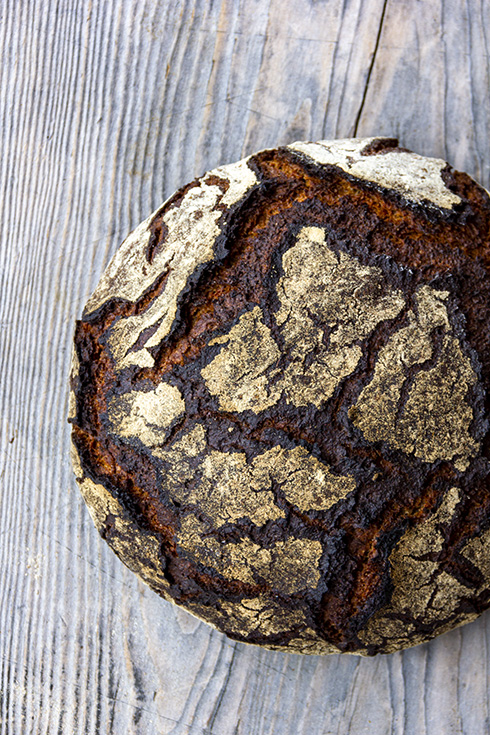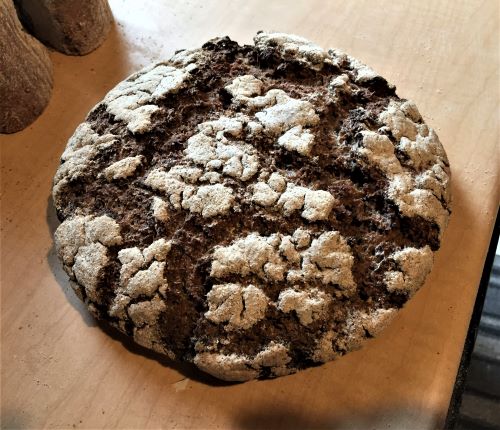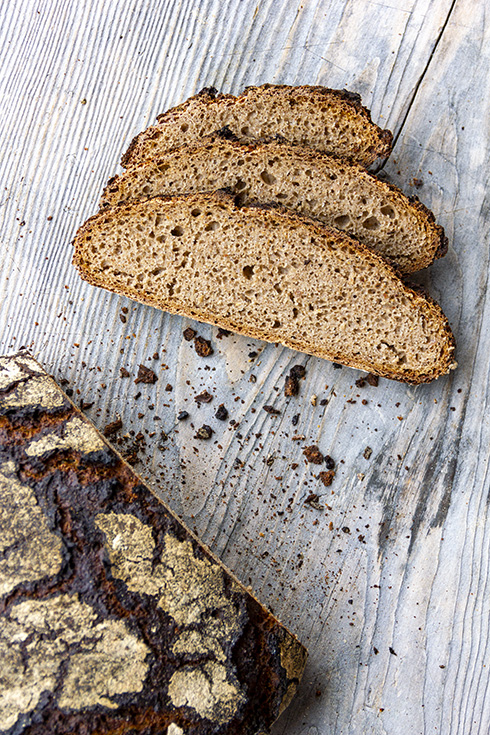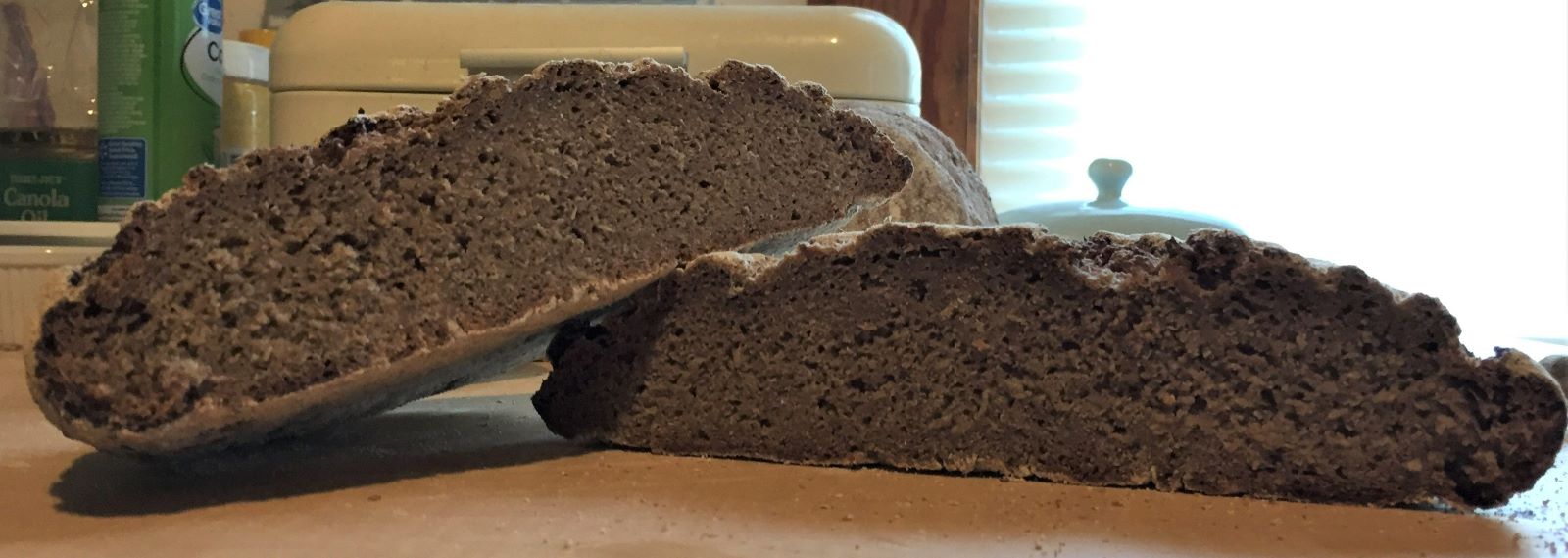I'm focusing on rye, and wending my way through the recipes of our own Hanseata, Karin; Lutz Geißler; and Brotdoc.
This is a second bake of Geißler's "Fröstlberg Kruste," which I find delicious. The balance of bread spice, gentle nip on the tongue of acidity and the nice sweetness generated from an overnight soak at 75 C* all make for a really nice bread, at least to the extent I am doing it justice.
However, it sure seems flat to me. That said, he does describe the loaf as "typically Austrian flat." (Mini?) Can't tell if it's flatter than Lutz has it (L is his, R is mine), but it seems flat. It came out of the oven at an internal temp of 97 C and rested 24 hours. It tastes to me just a touch gummy (and I do mean that literally. Right on the edge with "pleasantly moist," by my mouthfeel). My wife disagrees and calls it spot on. (She's a big dark rye lover, as an Estonian).




It's also funny that I see the same word in many German recipes, "saftiges," which I think means "juicy" or the like, yes? Is that indicating moistness, a pleasant moistness and not dry?
For these ryes, would you suggest a higher internal temp?
Are you seeing anything in the crumb photo that suggests a proofing or shaping (or other) issue?
Thanks for taking a look.
*Though this temp is right at the limit of amylase activity.. Any higher would denature even a-amylase. It's also curious to me he callse for the soak at this a-amylase range, ruling out any b-amylase activity entirely. Bears some thoughts.
That seems to scare flatlanders but it sure looks good to me. :)
I can't really see the crumb. Saftiges means juicy but more like moist in this case. How old was the bread when cut? And with what kind of knife? Got anothr crumb shot? Or is it gone already?
Lol. I live in the flattest flatlanding of flatlanders everywhere.
Please help me. I'll wink in morse.
Thanks mini, that's an imprimatur I can take in. Sorry for the crappy crumb shots. Rested 24 hours before opening, and you guessed it well, almost gone (thank god I am baking ryes daily, and I'm one day ahead!). Knife is a shamefully dull serrated. These aren't great either, but they're closer in:
with a straight sharp blade while I blow up the crumb.... I mean zoom in. :)
Lower crust looks a little pale, bake longer? Find that sharp knife yet? Show me the next loaf, this one hard to see. If you want it taller, try a form. How about a small frying pan with rounded sloping sides? Remove the handle if it can melt or burn.
I'm with the Missus. Internal temp looks good. I go with 96°C (206° F) for 100% rye, higher if wheat is involved. Flat bakes fast and dries out fast too. You get these nice long skinny open faced sandwiches. If cut at a slant the width can be increased.
Awesome, thanks for all these points, mini. Here's at least a better set (sorry, though, phone camera isn't the best) - thanks for the notion of using a sharp bladed knife - never actually knew that!
Next loaf. You mean I'm not done yet? I completed the internet, isn't that enough? :)
especially the middle and upper middle of the loaf. Might want to cut back on some of the liquids. Lower crust looks good and baked nicely. Yep, I just think there was too much liquid for this particular rye flour. Next loaf, less water.
Thanks for the clear crumb shots, helps a lot.
OK great, thank you Mini, that helps a good deal, especially the specific notes about the placement of defects. When I saw the clearer images, I saw various little regions having that "fruitcake" or pecan=pie crumb quality, like that larger hole center-right in the pics. (correct example?) I wanted to wait until someone who knew what she's doing would evaluate, so much appreciated.
The hydration test I learned from mariana awhile back somewhere, I presume it is relevant for rye as well as wheat because it's a test based on tackiness and not requiring the autolyse of the first test (which would obviously be irrelevant for rye). Is that a correct understanding?
In case others don't know the test(s) I'm talking of, here's a couple. As mentioned, the first one includes an autolyse and evaluates for dough strength. Mariana's is on an evaluation of "tacky" v. "sticky" and it nailed it for my hydration level for a "Rubaud blend flour." (73-74%).
And how did the rye flour test out? With rye, might start out with 75%, 80%, 84%, 86% with a little lemon juice or vinegar to acify the water used in the test. My current white rye flour sweet spot is 83% hydration.
The opal looking crumb says more than the air pocket. The crumb above the air pocket has that opal look. It can be that by lowering the hydration a slight slowing down of fermentation is also realized and welcomed.
I've found that for slicing anything above 50% rye breads, a straight sharp knife Is best and it can't be too long either.
Great, thanks mini. I presume you're acidifying to reflect the environment the flour will actually be in, given levain? Worthwhile hitting a given pH or TA, or is that overkill? Thanks for indicating to make the range higher, I wouldn't have thought to do that. And thanks for the tip on cutting rye-intensive breads. Thankfully I've a good battery of knives, remnants from my chef days.
I love your descriptor of "opal," perfect reflection.
Paul
starter and then try to mix something you can taste that would be similar sour. Ha! If too sour to taste or drink obviously too much added sour. There are many countries that drink a vinegar drink. Maybe a tablespoon or 15 ml 5% vinegar to 485 ml water? Just a guess. Measure it and check pH for your notes but I don't think it necessary and yes, imitating what the sd acid does to pull the rye "glue" together is the intension.
Lol, I know the romans, your average legionary, loved their vinegar. My wife likes to drink mother vinegar and I should too, I know it's healthy. That and bitter herbs.**
Helpful post as usual, mini. I'll give it a shot and let you know how it turns out. BTW have Lutz's "Berkruste" rye/spelt bread baking right now. Halfway through, this one smells wonderful.
**In Austria, is naturopathy commonplace? I have very close friends, smallhold farmers, 6 cows on milk, pastured only, they are trained naturopaths and will often give us some recommendations for things. I seem to recall homeopathy and naturopathy in Germany are not as unusual as they are here in the U.S. Could be wrong. Anyway, curious about your country.
is one of my favourite combinations. If they could, they would be happily married to each other like salt & pepper.
Have a slice with a light smear of sweet butter with some of that nutella nougat cream spread on top, open face. I dare you to only eat one slice.
I think native plants in Europe have a longer history of use than north american plants, unless you ask Native Americans.
Haha, don't know why, but the image of S & P made me giggle. As to the nutella et al, thou art truly wicked.
It would be interesting to do some digging on the history of their use in Europe. Couple of my books that I've really enjoyed are Gastronomy: The Anthropology of Food and Food Habits, and The Gastronomy of France. Crazy idea, but few look into it. How are the customs of the stuff we put in our mouths born and evolve, and why?